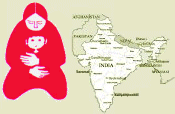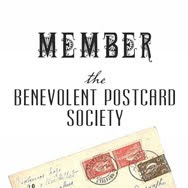I came across the website of a friend of mine, Michael Brehl. I met Michael and his wife Susan when my ex-husband and I were living in New York City, and my ex and Susan were working together at the Smithsonian’s Museum of the American Indian. They really are the most lovely people, and it was so nice to have such good friends during a really difficult time for us. They have two beautiful children, Roslyn and David.
Michael Brehl
July 26, 2004 at 3:26 am (Uncategorized)
I came across the website of a friend of mine, Michael Brehl. I met Michael and his wife Susan when my ex-husband and I were living in New York City, and my ex and Susan were working together at the Smithsonian’s Museum of the American Indian. They really are the most lovely people, and it was so nice to have such good friends during a really difficult time for us. They have two beautiful children, Roslyn and David.
Cradle to Cradle
July 23, 2004 at 4:26 pm (Uncategorized)

Cradle to Cradle
Basically, cradle to cradle design uses “eco-effective” processes and designs to produce products which, rather than being simply “recycleable”, are entirely recoverable or not only create no impact on the environment, actually improve the environment. Two examples that he referred to were Unilever, which has ice-cream packaging created from leaf-litter which not only bio-degrades in just a few hours, incorporates seeds from rare plants; and the Ford Motor Company which has introduced the Model U, produced using green materials and processes like soy-based componants and corn-based fillers in its tires, as well as green technologies, such as a revolutionary Hydrogen Internal-Combustion Engine which producess pollutant emissions at near zero (including carbon dioxide).

Enviro Packaging
In April, the EnvironDesign 8 conference included a presentation by MBDC co-counders McDonough and Braungart on the cradle to cradle approach to sustainablilty.
MBDC describes cradle to cradle design thusly:
“The cradle-to-cradle model recognizes two metabolisms within which materials flow as healthy nutrients. Nature’s nutrient cycles comprise the biological metabolism. Materials designed to flow optimally in the biological metabolism [such as Climatex Lifecycle], which we call biological nutrients, can be safely returned to the environment after use to nourish living systems. The technical metabolism, designed to mirror the Earth’s cradle-to-cradle cycles, is a closed-loop system in which valuable, high-tech synthetics and mineral resources—technical nutrients—circulate in a perpetual cycle of production, recovery and remanufacture. “
What Was Lost in Translation
July 23, 2004 at 3:42 am (Uncategorized)

It’s Suntory Time
DIRECTOR (in Japanese to the interpreter): The translation is very important, O.K.? The translation.INTERPRETER: Yes, of course. I understand.
DIRECTOR: Mr. Bob-san. You are sitting quietly in your study. And then there is a bottle of Suntory whiskey on top of the table. You understand, right? With whole hearted feeling, slowly, look at the camera, tenderly, and as if you are meeting old friends, say the words. As if you are Bogie in “Casablanca,” saying, “Cheers to you guys,” Suntory time!INTERPRETER: He wants you to turn, look in camera. O.K.?BOB: That’s all he said?INTERPRETER: Yes, turn to camera.BOB: Does he want me to, to turn from the right or turn from the left?INTERPRETER (in very formal Japanese to the director): He has prepared and is ready. And he wants to know, when the camera rolls, would you prefer that he turn to the left, or would you prefer that he turn to the right? And that is the kind of thing he would like to know, if you don’t mind.DIRECTOR (very brusquely, and in much more colloquial Japanese): Either way is fine. That kind of thing doesn’t matter. We don’t have time, Bob-san, O.K.? You need to hurry. Raise the tension. Look at the camera. Slowly, with passion. It’s passion that we want. Do you understand?INTERPRETER (In English, to Bob): Right side. And, uh, with intensity.
BOB: Is that everything? It seemed like he said quite a bit more than that.
DIRECTOR: What you are talking about is not just whiskey, you know. Do you understand? It’s like you are meeting old friends. Softly, tenderly. Gently. Let your feelings boil up. Tension is important! Don’t forget.INTERPRETER (in English, to Bob): Like an old friend, and into the camera.BOB: O.K.DIRECTOR: You understand? You love whiskey. It’s Suntory time! O.K.?BOB: O.K.DIRECTOR: O.K.? O.K., let’s roll. Start.BOB: For relaxing times, make it Suntory time.DIRECTOR: Cut, cut, cut, cut, cut! (Then in a very male form of Japanese, like a father speaking to a wayward child) Don’t try to fool me. Don’t pretend you don’t understand. Do you even understand what we are trying to do? Suntory is very exclusive. The sound of the words is important. It’s an expensive drink. This is No. 1. Now do it again, and you have to feel that this is exclusive. O.K.? This is not an everyday whiskey you know.INTERPRETER: Could you do it slower and ?DIRECTOR: With more ecstatic emotion.INTERPRETER: More intensity.DIRECTOR (in English): Suntory time! Roll.BOB: For relaxing times, make it Suntory time.DIRECTOR: Cut, cut, cut, cut, cut! God, I’m begging you.
Star Axis
July 23, 2004 at 2:06 am (Uncategorized)
Star Axis is an immense star observatory being created in New Mexico.
The artist, Charles Ross, is digging into a mesa to create his naked-eye observatory, a monumental work which is inspired by the ancient observatories of the peoples of the American Southwest, amongst others.The subject of Charles Ross’ art is light itself. Using sunlight and starlight as its source, the work manifests experiences of primal solar color, and star geometry in sculptural form. Ross’ work includes photographs, paintings and drawings, site-specific prism/solar spectrum light installations, Star Maps, Solar Burns, and his enormous earth/sky sculpture and naked-eye observatory, Star Axis.

Lines of Light, Rays of Color
Plaza of the Americas, Dallas, Texas
1985
Olympics? I don’t think so….
July 20, 2004 at 9:27 am (Uncategorized)
“The International Amateur Athletics Federation, the world governing body of Track & Field, posted a memo to all national Track & Field governing bodies late last year stating that the 2004 Olympic Marathon will be the premier event in Greece because that is where the event originated. The IAAF requested full participation (up to 3 athletes) per country in order to fill the men’s and women’s races. The IAAF even softened the international standard from 2:32 to 2:37 to ensure its goal was met. At that date, 4 Canadian runners had met the new women’s standard, but none of us had achieved the insurmountable 2:28:14 that the COC had set. What was Canada’s response to the IAAF? No change. One would still have to run faster than any Canadian women ever just to get to the Games. And so, for the second Olympics in a row, Canada will have no representation in the women’s Marathon. How will we get someone to Beijing in 2008 at this rate?I have met the International Olympic Marathon “A” standard twice this year, and I am Canada’s fastest female marathoner, yet I am still not good enough to represent Canada in Athens. No Canadians will get to take part in the historic marathon this summer. Is it really better to have no one racing rather than an athlete who is not ranked in the top 12 globally, but who: trains 2 to 3 hours a day, doesn’t take drugs, speaks in her community and works full-time? Sorry that Canada’s best just isn’t good enough.”
“Sotades at the ninety-ninth Festival was victorious in the long race and proclaimed a Cretan, as in fact he was. But at the next Festival he made himself an Ephesian, being bribed to do so by the Ephesian people. For this act he was banished by the Cretans. Pausanias, Description of Greece.*
“When the Persian military officer Tigranes “heard that the prize was not money but a crown [of olive], he could not hold his peace, but cried, ‘Good heavens, Mardonius, what kind of men are these that you have pitted us against? It is not for money they contend but for glory of achievement!'” Herodotus, Histories , 8.26.3“*
“Do you think, fellow citizens, that any man would ever have been willing to train for the pancratium or any other of the harder contests in the Olympic games…if the crown were given, not to the best man, but to the man who had successfully intrigued for it? No man would ever have been willing. But as it is, because the reward is rare…and because of the competition and the honor, and the undying fame that victory brings, men are willing to risk their bodies, and at the cost of the most severe discipline to carry the struggle to the end. Aeschines, Against Ctesiphon , 179“*
New Life
July 12, 2004 at 4:35 am (Uncategorized)
We haven’t seen them in almost two years, I am guessing and I was feeling very badly. We met when our
Fellowship sponsored the family as refugees from the war in Kosovo. We all became friends as well as sponsors and were torn when half the family went back to Kosovo. We were saddened further when Qamille, the grandmother of the family died a few months after returning to Pristina, their home.However, before the family left, the son and his wife had their first child, Kosovare. In fact, I was there for the birth, giving me the chance to have the most memorable experience in my life.
The eldest daughter returned home to Kosovo a little later, and gradually we lost touch. The family here, though, was growing. Another child was on the way. Sadly, Altina was born at 16 weeks, and despite a valiant struggle for life, she died months later, at about the date she should have been born, had fate not intervened. It was heartbreaking for all of us who felt so close to the family. It was devastating to see the impact on the young parents.
According to
Muslim tradition, there is a lengthy preparation before the funeral and the preparations are carried out by members of the Muslim community, friends and family. The preparations include the washing of the body and wrapping it in a winding cloth. I was really honored to participate in the preparations. For me, the fact that I had seen one of their daughters into the world, I felt that I should be there to help another out of the world. It was sad and beautiful, and gave be the chance to experience another facet of life that all of us face but rarely so closely, at least in our Western Christianize culture.I saw the family several times after this, but one thing and another kept us apart.
On our last visit, I played with Kosovare, then aged 2. We watched the air-balloons go by… one crashed on the side of the building, and we had a lovely time. However, I was conscious that this was our first visit as friends and, yet, despite our being so easy with the family as their sponsors and considering ourselves to be friends, I didn’t want them to feel obligated to be friends.
Last week, I got an email from Advije in Kosovo, updating me on her life and that of her family. She has a 9-month-old son named Andi. The family is well, and all was well. She also told me that the young couple here had another baby. I was thrilled, though sad that I hadn’t been able to participate in the birth this time around.
I called Agron and Nexmije and Mom and I went to visit. It was a terrific visit, not the least because of the presence of Klevis, two weeks old. I found that our relationship is firmly that of dear friends and I needn’t have worried about them feeling “obligated” to be friends. We are and it is wonderful.
Nexmije said that she regretted my not having been with her for the birth. They had tried to call, but didn’t have me new phone number and my old cellphone was no longer working. Ah well, Klevis is hearty and healthy, and that is all that counts. As you can see below, he is a beautiful, beautiful baby.

Klevis, age 2 weeks
New Life
July 11, 2004 at 9:35 pm (Uncategorized)
We haven’t seen them in almost two years, I am guessing and I was feeling very badly. We met when our
Fellowship sponsored the family as refugees from the war in Kosovo. We all became friends as well as sponsors and were torn when half the family went back to Kosovo. We were saddened further when Qamille, the grandmother of the family died a few months after returning to Pristina, their home.However, before the family left, the son and his wife had their first child, Kosovare. In fact, I was there for the birth, giving me the chance to have the most memorable experience in my life.
The eldest daughter returned home to Kosovo a little later, and gradually we lost touch. The family here, though, was growing. Another child was on the way. Sadly, Altina was born at 16 weeks, and despite a valiant struggle for life, she died months later, at about the date she should have been born, had fate not intervened. It was heartbreaking for all of us who felt so close to the family. It was devastating to see the impact on the young parents.
According to
Muslim tradition, there is a lengthy preparation before the funeral and the preparations are carried out by members of the Muslim community, friends and family. The preparations include the washing of the body and wrapping it in a winding cloth. I was really honored to participate in the preparations. For me, the fact that I had seen one of their daughters into the world, I felt that I should be there to help another out of the world. It was sad and beautiful, and gave be the chance to experience another facet of life that all of us face but rarely so closely, at least in our Western Christianize culture.I saw the family several times after this, but one thing and another kept us apart.
On our last visit, I played with Kosovare, then aged 2. We watched the air-balloons go by… one crashed on the side of the building, and we had a lovely time. However, I was conscious that this was our first visit as friends and, yet, despite our being so easy with the family as their sponsors and considering ourselves to be friends, I didn’t want them to feel obligated to be friends.
Last week, I got an email from Advije in Kosovo, updating me on her life and that of her family. She has a 9-month-old son named Andi. The family is well, and all was well. She also told me that the young couple here had another baby. I was thrilled, though sad that I hadn’t been able to participate in the birth this time around.
I called Agron and Nexmije and Mom and I went to visit. It was a terrific visit, not the least because of the presence of Klevis, two weeks old. I found that our relationship is firmly that of dear friends and I needn’t have worried about them feeling “obligated” to be friends. We are and it is wonderful.
Nexmije said that she regretted my not having been with her for the birth. They had tried to call, but didn’t have me new phone number and my old cellphone was no longer working. Ah well, Klevis is hearty and healthy, and that is all that counts. As you can see below, he is a beautiful, beautiful baby.

Klevis, age 2 weeks
Tonight on Radio One
July 11, 2004 at 3:35 am (Uncategorized)
If you get a chance to listen to the Radio One program, Routes Montreal tonight, it is really good.I was listening to the tail end one the car radio (it is really great “driving music”) and have the live feed from the Edmonton CBC Radio One.
Tonights artists are:
“This turntable kills Fascists… Woody would have wanted it that way.” Buck 65 has a sort of Blues/Rap/Dub/Tom Waits sound…..
and
Rob recommends Creative Radio Central, an online radio station which is featuring Blackie and the Rodeo Kings. My personal favorite song from the newest Rodeo Kings CD, Bark, is “Stoned“. Now THAT is a “road tune”!











